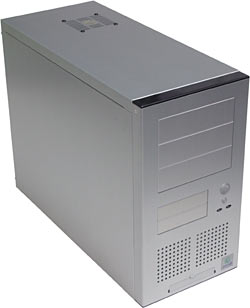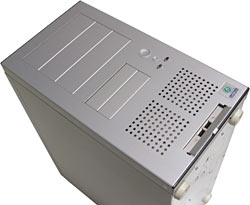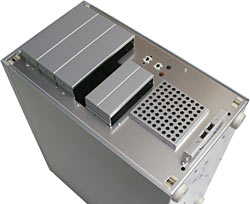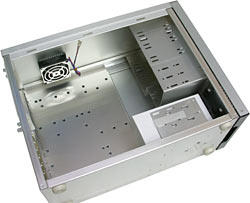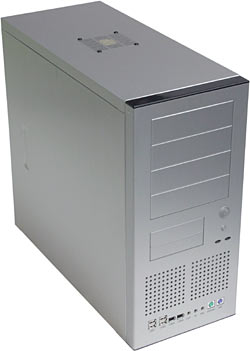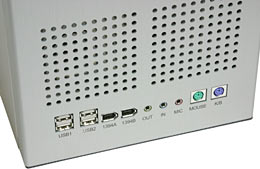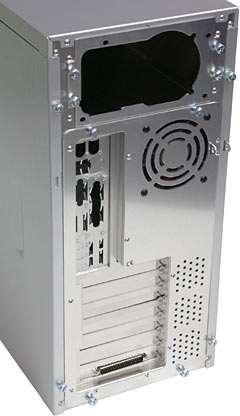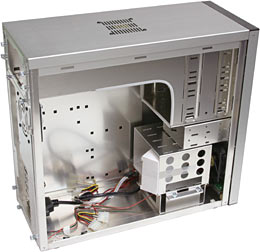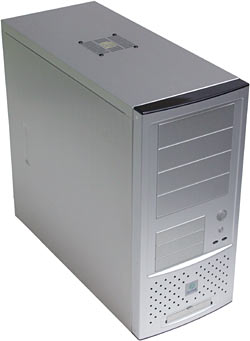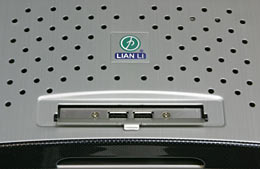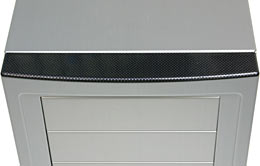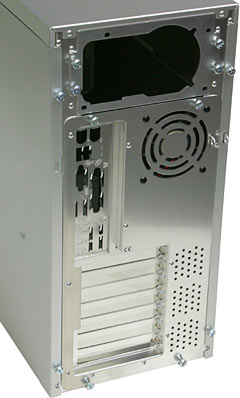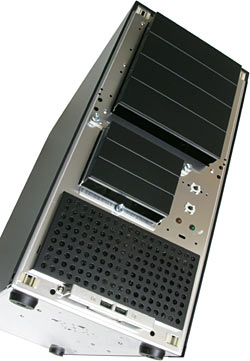
Lian Li PC-50, PC-601, PC-6100 and PC-7B computer cases
Review date: 4 July 2002.Last modified 03-Dec-2011.
Lian Li are not a company that believes in sticking to a few clearly delineated products. Their principal product line is high grade aluminium computer cases, but they seem to come out with a new model of case every couple of weeks.
All of Lian Li's cases are lightweight, they all have excellent ventilation thanks to extra fans mounted as standard, they're all very well made, they're all easy to work on, and they're all quite expensive, too. But the Lian Li range now covers everything from big serious server boxes (like the PC-76, reviewed here) to little microATX boxes (like the PC-42, reviewed here); their range expansion is now pretty much forced into new niches, not whole new kinds of enclosure.
As a result, a lot of Lian Li's new models are pretty much the same as something they make already. There's no point doing a whole separate review of something that can be summed up as "like this other one, only black and with a window in the side".
So I'll give you the rundown on four new Lian Li cases on this one page.
The PC-50
First up, the little PC-50. Aus PC Market here in Australia are selling this one for a mere $AU220 without power supply. That's cheap, by Lian Li standards. The price includes delivery in the Sydney metropolitan area; buyers from elsewhere in Australia will pay more. Buyers from other countries will have to find another supplier, as Aus PC don't ship overseas - international shipping for computer cases is ludicrously expensive, anyway.
US buyers should check out JCL, who are a pretty major distributor and reseller. They have an online retail store now.
By the way, if you're an Aussie who's eager to go to Aus PC Market and start buying stuff right now, click here!
Advertisement concludes. Review continues.
Like other small Lian Lis, the PC-50 isn't as tiny as it looks from the front, because it's unusually deep. It's about 38cm high by 20.5cm wide by 50cm deep (15 by 8.125 by 19.5 inches), and in overall layout and features it's essentially an up-sized PC-30. I review the PC-30 here; the PC-50 has three 5.25 inch drive bays instead of two, and an offset top-mounted exhaust fan, but it's otherwise very similar.
The PC-50's front panel follows Lian Li's usual styling for their brushed aluminium cases (which are all, by the way, hard-anodised, so the finish doesn't scratch easily). The panel's aluminium, to match the drive bay covers, and the trim strips at top and bottom are fake carbon fibre. They're a well enough done fake that they look fine, though.
Like many current Lian Lis, the PC-50 has a flip-down door at the bottom of the front panel. There are two USB ports behind it. Many of their current cases have four ports, but two will probably do.
The front panel clips on and is easy to pull free. Underneath, it's pretty plain; there's one 80mm intake fan with dust filter (the aluminium retainer over the filter is easy to remove), but there isn't a speed control for the intake fan, or a removable 3.5 inch drive cage. The drive bay covers are the clip-in type, though, and mounting drives is still pretty easy.
From the back, you can see that the PC-50 has the usual Lian Li thumbscrews holding the panels on (practically everything in the case that screws on has thumbscrews), and one of their usual removable, reversible plates for mounting the power supply. But there's no slide-out motherboard tray. You do get a padlock tab on the internal-access side panel for something resembling physical security, though.
As with various other Lian Lis, there are three multi-holed spots next to the the expansion card area where you can, if you like, install 40mm fans. There's not a lot of point to that, though, as 40mm fans don't move much air compared with their larger brethren. It depends on the exact fan specs, of course, but unless you're dealing with unusually grunty 40mm fans and unusually lazy 80mm ones, you'll probably find you need about five 40mm units to equal one ordinary 80mm. See my old fan speed comparison table here for a rough guide to the air-moving capacity of ordinary mass-market fans.
For this reason, just leaving the 40mm mounting spots as ventilation holes is very likely to be fine - or, at least, no worse than putting ineffective fans there.
Take off the PC-50's side panel and you see a pretty conventional small-Lian-Li layout. The three 5.25 inch bays and two of the middle 3.5 inch bays are "external", with front panel cut-outs, but there's another 3.5 inch bay in the middle cradle, and three more at the bottom behind the intake fan. So you can put a pretty impressive drive-farm in this little case, if you want.
It may be small, but the PC-50 isn't a microATX case; it accepts normal ATX motherboards and power supplies. You might have some issues if you want to use an unusually tall CPU cooler, as the PSU sits above the motherboard. But if you can stand to use a cooler that isn't topped by a monster Focussed Flow Delta air-shifter, you ought to be OK.
The two front USB ports connect to your motherboard USB headers (assuming your motherboard has extra USB headers - practically every motherboard has at least two, these days) via Lian Li's usual split-up micro-plugs, to accommodate different USB header pinouts. You only need four wires per port, so it's not likely to be terribly difficult to connect the plugs, but you will need to know your motherboard's USB header layout. The motherboard manual ought to tell you.
The front ports should work fine with USB 1.1 and USB 2.0 headers; all of Lian Li's current cases with front USB ports are USB 2.0 compatible.
For $AU220 (plus more for delivery, if you're an Aussie shopper outside metropolitan Sydney), the PC-50 isn't a bad deal at all. It's got many of the standard Lian Li features, it looks great, and there's more room inside it than you might think. You could build a perfectly good performance PC in one of these things, and end up with a nicely portable computer, if that matters to you.
Recommended.
The PC-601
This case is, basically, a PC-60 - the ISO Standard Platinum-Iridium Lian Li Case. It's got the same "fat midi-tower" dimensions as a PC-60, and it costs only slightly more than the current PC-60USB; Aus PC Market are selling it for $AU363 including Sydney metro delivery, without PSU.
But the PC-601 has a few differences, not the least of which is a lot more ports on the front than usual.
Four USB ports, two IEEE-1394 (FireWire) ports, three 1/8th inch audio connectors, and PS/2 ports for mouse and keyboard as well.
The front panel unclips easily, again, and reveals the circuit board that all those connectors live on. There are the usual two intake fans with filter, but there's no speed controller for them. There are also only two external 3.5 inch bays, versus the three on the front of the PC-60. These bays aren't removable, either; they're riveted in place.
The back of the PC-601 displays the normal removable PSU plate, and a slide-out motherboard tray, and two padlock tabs - one for the side panel, and one for the tray. As with the other PC-60-series cases, a rear exhaust fan is standard equipment. There's another exhaust fan on the top panel.
And then there's the hefty 37-pin D connector, pre-installed in the bottom expansion slot.
This is what plugs into that connector. It's a loopback cable for all but two of the front panel connectors. Because there's no way to connect audio and PS/2 stuff inside a case, you have to loop the connectors around the back, and that's what this thing does. It's also got two IEEE-1394 connectors; if you're using a PCI FireWire controller card then you'll probably have at least one internal FireWire connector, but this cable wants to plug into external ones.
The two front USB connectors aren't represented here, because they use the standard micro-plugs for connection to motherboard headers.
Inside the PC-601, the only oddities are the result of the chunky cable for the front ports. The cable runs under the bottom 3.5 inch drive cage, which means the cage has to be raised. The raised cage means the middle 3.5 inch cradle only has room for two drives.
The bottom cage is Lian Li's vertical-mount type, though, so it's got room for another five drives, and it's well cooled by the two intake fans. You probably won't miss one 3.5 inch bay.
If you've got a use for all of those front connectors, the PC-601 is a fine choice. It's got almost all of the features of the PC-60USB, it doesn't cost much more, and you can plug a whole system worth of peripherals into the front panel.
If you don't care about that, though, then a PC-60USB is a better buy.
The PC-6100
Another PC-60-ish case, the PC-6100's a bit cheaper, at $AU308 from Aus PC Market, including Sydney metro delivery but no PSU.
The front panel is aluminium (some cheaper Lian Lis, like the PC-5 and PC-6 I review here, have plastic fronts), and it's slightly curved at the top and bottom. You get the standard PC-60 external bay complement (four 5.25 inch, three 3.5 inch), plus a port door at the bottom, and the silver plastic power and reset buttons that Lian Li are now using more often than the boring beige versions.
Behind the front panel door there are only two USB ports, versus the four on the PC-60USB. They're fed by micro-plugs, again.
The fake carbon fibre trim in detail (remember, you can click the image for a larger version). It really does look perfectly acceptable, and goes well with brushed aluminium.
Pop off the PC-6100's front panel, and you've got almost a normal PC-60USB. Just the two USB ports, and no fan speed controller, but that's it for the significant differences.
The twin front fans have the PC-60-style filter retainer, which is a bit more fiddly to remove than the metal-cage type, but which lets more air through. It's just a couple of push-fit plastic clips, one on each side of the otherwise uncovered filter.
The 3.5 inch drive cage is held in place with three thumbscrews, as with the PC-60. So it's easy to remove it for drive installation.
The back of the PC-6100 is exactly the same as the back of the PC-610, except there's no loopback cable connector. PSU plate, motherboard tray, exhaust fan (and there's another one on the top, again), twin padlock tabs.
Inside, the PC-6100 looks like a PC-60USB, apart from the lack of a front fan speed controller, and only two front USB port cables. Tons of 3.5 inch bays, easy access, bright and shiny. The usual deal.
If you don't mind sacrificing a front fan speed controller, the PC-6100's a slightly more economical alternative to the PC-60USB. They're really pretty much exactly the same, though.
The PC-7B
Want a cheap black Lian Li with a proper metal front panel? Here one is.
The PC-7B isn't cheap by the standards of normal steel cases, of course. Aus PC Market's Sydney-metro-delivered, no-PSU price for it is $AU253. Most of the other black midi-tower Lian Lis are quite a lot more expensive, though; you'll pay $AU412.50 for a PC-61 (reviewed here), for instance. But the PC-12, which is basically just a black PC-60, is only $AU264.
The PC-12 is an older model, though; I'm pretty sure that all PC-12s on the shelves today lack front USB ports, and they may even still have the older front panel clip system, which is much more fiddly than the newer arrangement.
But the PC-12 does have a front fan speed control, and a motherboard tray. The PC-7B doesn't have either.
The PC-7B sports Lian Li's more straightforward kind of fan filter retainer, but black-anodised so as not to show through the front panel grille.
The inside of the case is silver, though; if you want a windowed case that light just seems to fall into, you'll do better to buy the Atlas (Super Flower, actually) SF-201B I review on this page. It's the only black case I know of that's black on the inside, too.
Given that the price difference is only eleven Australian dollars, I'd rather have a PC-12 than a PC-7B. There's nothing really wrong with the 7B, and it's definitely got the few new and improved bits which a PC-12 may or may not have. I'm not making any bets about possible changes made by Lian Li to one model over the years; PC-12s may well beat PC-7Bs across the board, by now, assuming someone doesn't sell you old stock. But even if they don't, they've got a couple more features and cost only slightly more.
Overall
None of these cases break much new ground. The PC-50's the most unusual of them, and it's still not very odd.
If you're used to plain old cheapie steel computer cases, though, where right angles are defined as anything from 85 to 105 degrees, rubber mallets are de rigeur for getting side panels on and off, and celebration is called for if you manage to complete a system upgrade without bleeding all over the motherboard, then any Lian Li will be a revelation. Yes, they're expensive, but the price is at least somewhat justified. And compared with the price of the rest of the bits that go into a cutting-edge PC, the premium for a Lian Li box really isn't that big.
The above four cases aren't anything special by Lian Li standards, but they're still something very special compared with what practically everybody's using. For home users who want something cool looking and easy to work on, or for LAN-party-goers who need to keep up with the Joneses, or indeed for companies who want to outfit their office with a gaggle of good value clones but don't want it to look that way, any Lian Li is a good idea.
So, generally, I recommend the lot of them.
Buy several! Collect the set!
Buy one!
Readers from Australia can purchase Lian Li cases from
Aus PC Market.
Click
here!
(if you're NOT from Australia, don't bother!)
